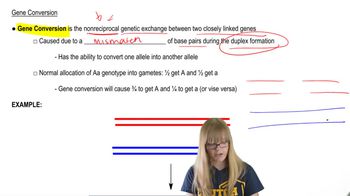Table of contents
- 1. Introduction to Genetics51m
- 2. Mendel's Laws of Inheritance3h 37m
- 3. Extensions to Mendelian Inheritance2h 41m
- 4. Genetic Mapping and Linkage2h 28m
- 5. Genetics of Bacteria and Viruses1h 21m
- 6. Chromosomal Variation1h 48m
- 7. DNA and Chromosome Structure56m
- 8. DNA Replication1h 10m
- 9. Mitosis and Meiosis1h 34m
- 10. Transcription1h 0m
- 11. Translation58m
- 12. Gene Regulation in Prokaryotes1h 19m
- 13. Gene Regulation in Eukaryotes44m
- 14. Genetic Control of Development44m
- 15. Genomes and Genomics1h 50m
- 16. Transposable Elements47m
- 17. Mutation, Repair, and Recombination1h 6m
- 18. Molecular Genetic Tools19m
- 19. Cancer Genetics29m
- 20. Quantitative Genetics1h 26m
- 21. Population Genetics50m
- 22. Evolutionary Genetics29m
20. Quantitative Genetics
Analyzing Trait Variance
Problem 29c
Textbook Question
A three-gene system of additive genes (A, B, and C) controls plant height. Each gene has two alleles (A and a, B and b, and C and c). There is dominance among the alleles of each gene, with alleles A, B, and C dominant over a, b, and c. Under this scheme, the dominant genotype for a gene contributes 10 cm to height potential, and the recessive genotype contributes 4 cm. What is the height potential of the F₁ progeny of the homozygous plants identified in (a) and (b) of this problem?
 Verified step by step guidance
Verified step by step guidance1
Step 1: Understand the genetic system described in the problem. Each gene (A, B, and C) has two alleles: a dominant allele (A, B, C) and a recessive allele (a, b, c). The dominant allele contributes 10 cm to plant height, while the recessive allele contributes 4 cm.
Step 2: Determine the genotypes of the homozygous parent plants mentioned in parts (a) and (b). Homozygous means both alleles for each gene are the same. For example, one parent could be homozygous dominant (AA, BB, CC), and the other could be homozygous recessive (aa, bb, cc).
Step 3: Predict the genotype of the F₁ progeny. When crossing a homozygous dominant parent (AA, BB, CC) with a homozygous recessive parent (aa, bb, cc), the F₁ progeny will inherit one dominant allele and one recessive allele for each gene, resulting in a heterozygous genotype (Aa, Bb, Cc).
Step 4: Calculate the height contribution of each gene in the F₁ progeny. Since the F₁ progeny are heterozygous (Aa, Bb, Cc), the dominant allele in each gene will determine the height contribution. For each gene, the dominant allele contributes 10 cm.
Step 5: Add the height contributions from all three genes to determine the total height potential of the F₁ progeny. Sum the contributions from the dominant alleles of genes A, B, and C to find the total height potential.
 Verified video answer for a similar problem:
Verified video answer for a similar problem:This video solution was recommended by our tutors as helpful for the problem above
Video duration:
3mPlay a video:
Was this helpful?
Key Concepts
Here are the essential concepts you must grasp in order to answer the question correctly.
Additive Gene Action
Additive gene action refers to the cumulative effect of multiple genes on a single trait, where each gene contributes a specific amount to the phenotype. In this case, the three genes (A, B, and C) each add to the plant height, with dominant alleles contributing more than recessive ones. Understanding this concept is crucial for predicting the overall phenotype based on the genotypes of the parents.
Recommended video:
Guided course

Mapping Genes
Dominance and Alleles
Dominance describes the relationship between alleles, where a dominant allele masks the effect of a recessive allele in a heterozygous genotype. In this scenario, alleles A, B, and C are dominant over their respective recessive alleles a, b, and c. Recognizing which alleles are dominant helps in determining the potential contributions to the phenotype from each gene.
Recommended video:
Guided course

Variations on Dominance
Genotype to Phenotype Conversion
The conversion from genotype to phenotype involves translating the genetic makeup (genotype) into observable traits (phenotype). In this problem, the height potential is calculated based on the genotypes of the homozygous parent plants, where each dominant allele contributes 10 cm and each recessive allele contributes 4 cm. This understanding is essential for calculating the expected height of the F₁ progeny.
Recommended video:
Guided course

Gene Conversion

 8:34m
8:34mWatch next
Master Analyzing Trait Variance with a bite sized video explanation from Kylia
Start learningRelated Videos
Related Practice
Textbook Question
A three-gene system of additive genes (A, B, and C) controls plant height. Each gene has two alleles (A and a, B and b, and C and c). There is dominance among the alleles of each gene, with alleles A, B, and C dominant over a, b, and c. Under this scheme, the dominant genotype for a gene contributes 10 cm to height potential, and the recessive genotype contributes 4 cm.What is the height potential of a plant that is homozygous for all three recessive alleles?
611
views
